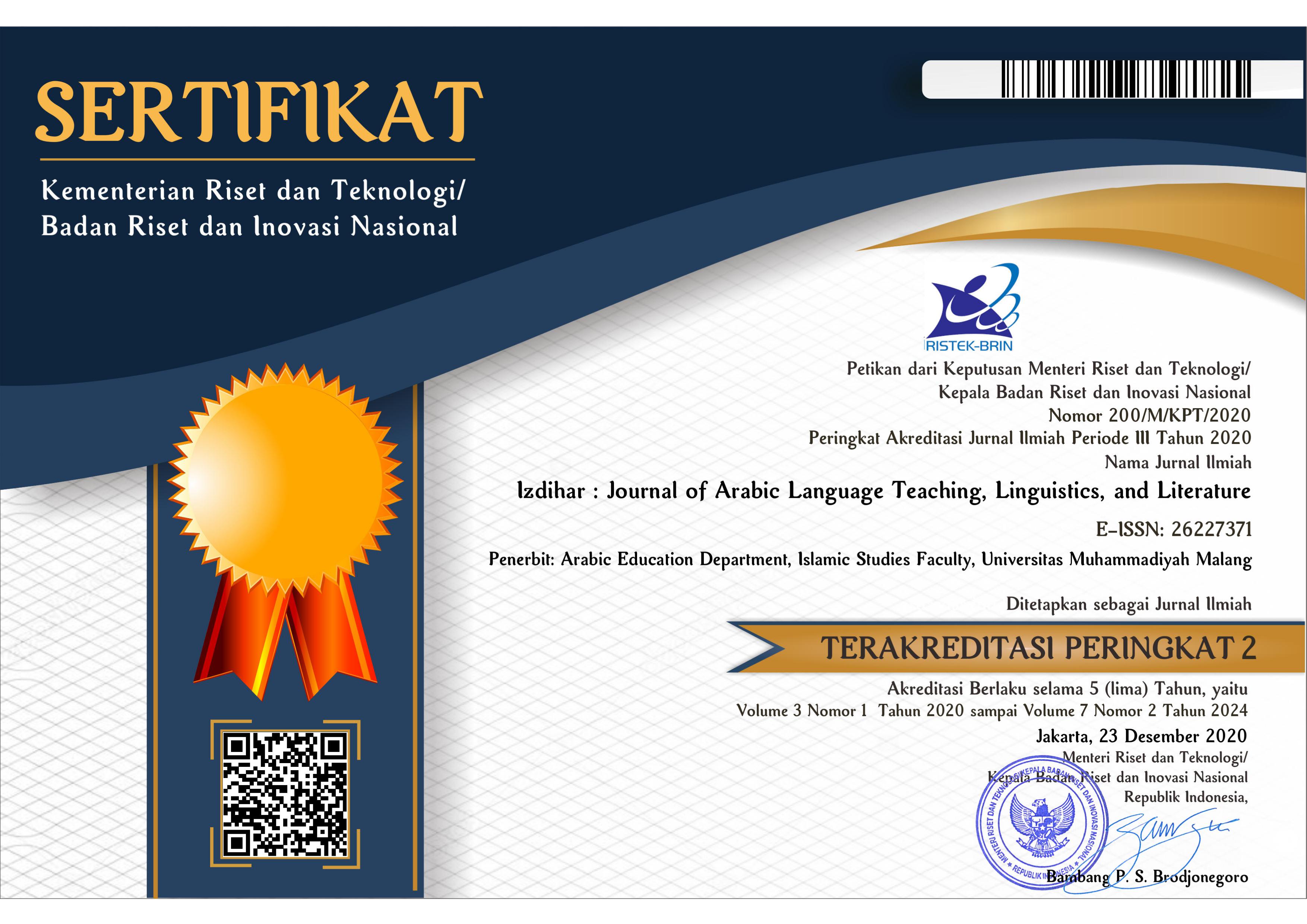The Existence of Majaz Mursal in Surah Al-Baqarah from the Perspective of ‘Ilmu Al-Bayan
DOI:
https://doi.org/10.22219/jiz.v5i1.18682Keywords:
Al-Baqarah, Bayan Science, Majaz MursalAbstract
This study analyzed Majaz mursal contained in Surah Al-Baqarah according to Bayan Science Perspective. Majaz mursal is part of majaz lughawi which discusses the use of lafazd not for its original meaning because there is alaqah which is in addition to likeness and there is also currynah that blocks understanding with the meaning of haqiqi (original). Research methods are libraryresearch, and data analysis techniques that use qualitative descriptive analysis techniques. The result of this study is that "Majaz mursal in surat Al-Baqarah there are sixteen verses, namely Majaz Sababiyah is in verse 55, Musabbabiyah is in verses 174, 235, Majaz Juziyyah is found in verses 43, 112, 115, 125, 144, 177. Kuliyyah is found in verses 50, 19, Majaz I'tibaru ma'kana is not found in surat Al-Baqarah, Majaz I'tibaru maa yakuunu is found in verses 17, 49, 230, Majaz Mahaliyyah is found in verse 9, Majaz Haliyyah is found in verse 81, and Majaz Aliyah is not found in Surah Al-Baqarah.
Downloads
References
Al-Baghdadi, S. al-A. (n.d.). Ruhul ma’ani fi tafsir al-Qur’an al-azhim was Sab’il Matsani. Darul Ihya Turatsil Arabiyyah.
Al-Bustani, K. (1960). Al-Munjid fi al-Lughah wal "a‟lam. Maktabah Syarqiyyah.
Ali Al-jarimi & Musthafa Amin. (1999). Al-balaghah al-wadihah (pp. 1–308). Daarul maarif.
Ash-Shabuni, M. A. (1985). At-Tibyan fi Ulum al-Qur’an, ’Alam al-Kutub.
Ash-Shaukani, M. bin A. (1964). Fathul Qadir. Darul Fikr.
Ash-Shawi, A. (1993). Hasyiyatush Shawi "ala Tafsir al-Jalalain, Juz 1. Darul Fikri.
Atmawati, D. (2014). Majaz dalam Al-Qur’an (kajian terhadap al-qur’an terjemahan juz 30). LiNGUA: Jurnal Ilmu Bahasa Dan Sastra, 9(1), 1–8. https://doi.org/10.18860/ling.v9i1.2552
Bustami, H. (2013). Ayat-ayat tamtsîl Al-Qur`an (analisis stilistika). Al-Ta Lim Journal, 20(1), 285–298. https://doi.org/10.15548/jt.v20i1.25
Sukamta. (1999). Majaz dalam Al-Qur’an (Sebuah Pendekatan terhadap Pluralitas Makna). Disertasi, 1–60.
Ekawati. (2019). Majâz Al-Qur’an dalam perspektif sejarah. Hikmah, 15(2), 338–358.
Fajria, N. (2020). Korelasi Al-Îjâz dan Al-Iṭnâb dengan Maqâṣid As-Suar (Studi dalam Kisah Nabi Musa as). Syariati: Jurnal Studi Al-Qur'an dan Hukum, 6(01), 17-30. https://doi.org/10.32699/syariati.v6i01.1257
Fauzi, M. F., Murdiono, M., Anindiati, I., Nada, A. L. I., Khakim, R. R., Mauludiyah, L., & Thoifah, I. (2020). Developing Arabic language instructional content in Canvas LMS for the era and post covid-19 pandemic. Izdihar : Journal of Arabic Language Teaching, Linguistics, and Literature, 3(3), 161–180. https://doi.org/10.22219/jiz.v3i3.15017
Firdaus. (2018). Hakikat dan majaz dalam Al-Qur’an dan sunnah. Jurnal Kajian dan Pengembangan Umat, 1(1), 43–57.
Hadi, N. (n.d.). Kontribusi al-Qur’an terhadap Perkembangan Bahasa Arab. 1.
Irdayanti. (2017). Analisis majaz mursal pada kitab Riyaḍuṣṣāliḥīn karya Imam Nawawi. In skripsi sarjana.
As-Suyuthi, J. A. A. B. (1988). Mu‟tarakul "Aqran. , Darul Kutub al-Ilmiyyah.
As-Suyuthi, J. A. A. B. (1988). Mu‟tarakul "Aqran fi I‟jāzil Qur‟ān, Volume I. Darul Kutub al-Ilmiyyah.
Ichwan, M. N. (2002). Understanding the language of the Qur’an: Reflection on linguistic issues. Yogyakarta Student Library in Collaboration WithWalisongo Press IAIN Walisongo.
Masdar, M. I. (2019). Pengembangan Bahan Ajar Ilmu Bayan Berbasis Analisis Kontrastif di Program Studi Pendidikan Bahasa Arab Sekolah Tinggi Ilmu Al-Quran. Fenomena, 11(1), 1–16. https://doi.org/10.21093/fj.v11i1.1368
ad-Darwisy, M. (1993). I’rabul-Qur’anil-Karim wa Bayanuh. Daarul Ma’arif.
Murdiono. (2020). Al-Qur’an sebagai media pembelajaran Ilmu Bayan. UMMPRESS.
Abu Zaid, N. M. (1992). Naqd alkhitab aldiniy. Maktabah Matbuli.
Nawafi, M. M. (2017). Eksistensi majas dalam Alqur’an sebagai khazanah keilmuan Islam. Al-A’raf : Jurnal Pemikiran Islam Dan Filsafat, 14(2), 239. https://doi.org/10.22515/ajpif.v14i2.481
Noor, M. S. (2013). Majaz mursal dalam surah Al-Baqarah. Jurnal Al Maqayis, 1(2), 1–25. http://dx.doi.org/10.18592/jams.v1i2.133
Radhiy, S. (1986). Talkhish al-bayan fi majāzātil Qur’an. Alam al-Kutub.
Suryani, K. (2019). Keunggulan bahasa Al-Qur’an di bidang sastra (al-balaghah) dalam pandangan Ibn Asyur. Dar El-Ilmi: Jurnal Studi Keagamaan, Pendidikan Dan Humaniora, 6(2), 220–245.
Thabrani, A. (2018). Nadzam dalam i’jaz Al-Quran menurut Abdul Qahir Al Jurjani. Al Mi’yar: Jurnal Ilmiah Pembelajaran Bahasa Arab Dan Kebahasaaraban, 1(1), 1-14. https://doi.org/10.35931/am.v1i1.80
Walidah, Z., Yanuar, M., Azizah, D. N., & Qalyubi, S. (2020). Stylistic analysis in Surah Al-Najm. Izdihar : Journal of Arabic Language Teaching, Linguistics, and Literature, 3(2), 129–146. https://doi.org/10.22219/jiz.v3i2.11624
Yasin, H. (2020). Sisi balaghah dalam Tafsir Al-Baidhawy. Tahdzib Al-Akhlaq: Jurnal Pendidikan Islam, 3(2), 41–61. https://doi.org/10.34005/tahdzib.v3i2.894
Zubaidillah, M. H. (2018). Haqiqah dan majaz dalam Alquran. INA-Rxiv, 7(1), 1–14. https://doi.org/10.31227/osf.io/fzatu
Downloads
Published
How to Cite
Issue
Section
License
Copyright (c) 2022 Izdihar, M Murdiono, Lailatul Mauludiyah, Muhamad Amin, Renat Sarimov

This work is licensed under a Creative Commons Attribution-ShareAlike 4.0 International License.
Copyright Notice
Authors who publish with this journal agree to the following terms:
- Authors retain copyright and grant the journal right of first publication with the work simultaneously licensed under a Creative Commons Attribution-ShareAlike 4.0 International License that allows others to share the work with an acknowledgment of the work's authorship and initial publication in this journal.
- Authors are able to enter into separate, additional contractual arrangements for the non-exclusive distribution of the journal's published version of the work (e.g., post it to an institutional repository or publish it in a book), with an acknowledgment of its initial publication in this journal.
- Authors are permitted and encouraged to post their work online (e.g., in institutional repositories or on their website) prior to and during the submission process, as it can lead to productive exchanges, as well as earlier and greater citation of published work (See The Effect of Open Access).
Copyright (c) 2019 Izdihar : Journal of Arabic Language Teaching, Linguistics, and Literature

This work is licensed under a Creative Commons Attribution-ShareAlike 4.0 International License.


















